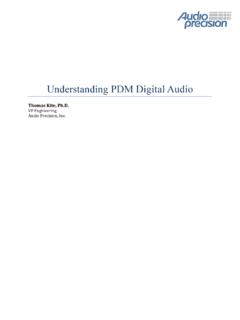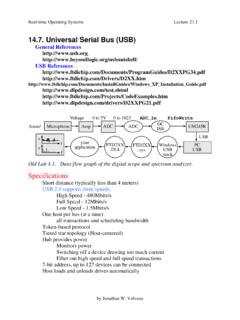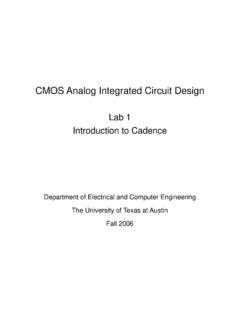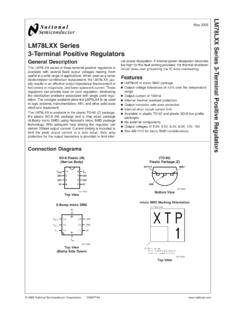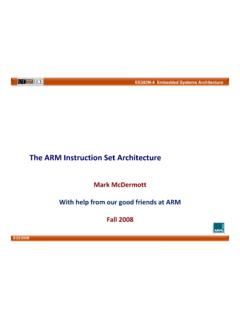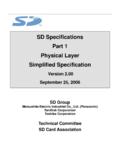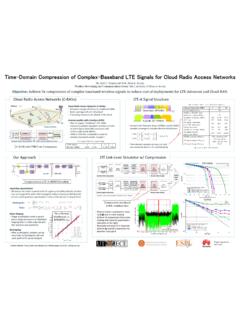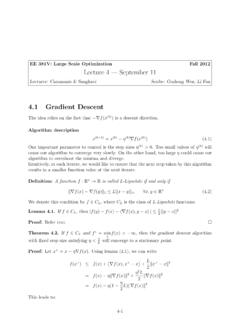Transcription of Symmetrical Components 1. Transformation Matrix
1 Symmetrical Components Transformation matrices and the decoupling that occurs in balanced three-phase systems. Physical significance of zero sequence. 1. Transformation Matrix Fortescue's Theorem: An unbalanced set of N related phasors can be resolved into N systems of phasors called the Symmetrical Components of the original phasors. For a three-phase system ( N = 3), the three sets are: 1. Positive Sequence - three phasors, equal in magnitude, 120o apart, with the same sequence (a-b-c) as the original phasors. o 2. Negative Sequence - three phasors, equal in magnitude, 120 apart, with the opposite sequence (a-c-b) of the original phasors.
2 3. Zero Sequence - three identical phasors ( equal in magnitude, with no relative phase displacement). The original set of phasors is written in terms of the Symmetrical Components as follows: ~ ~ ~ ~. Va = Va 0 + Va1 + Va 2 , ~ ~ ~ ~. Vb = Vb0 + Vb1 + Vb 2 , ~ ~ ~ ~. Vc = Vc 0 + Vc1 + Vc 2 , where 0 indicates zero sequence, 1 indicates positive sequence, and 2 indicates negative sequence. The relationship among the sequence Components for a-b-c are Positive Sequence Negative Sequence Zero Sequence ~ ~ ~ ~ ~ ~ ~. Vb1 = Va1 1 120 o Vb 2 = Va 2 1 + 120 o Va 0 = Vb0 = Vc 0.
3 ~ ~ ~ ~. Vc1 = Va1 1 + 120 o Vc 2 = Va 2 1 120 o The Symmetrical Components of all a-b-c voltages are usually written in terms of the Symmetrical Components of phase a by defining a = 1 + 120 o , so that a 2 = 1 + 240 o = 1 120 o , and a 3 = 1 + 360 o = 1 0 o . Page 1 of 5. ~ ~ ~. Substituting into the previous equations for Va , Vb , Vc yields ~ ~ ~ ~. Va = Va 0 + Va1 + Va 2 , ~ ~ ~ ~. Vb = Va 0 + a 2Va1 + aVa 2 , ~ ~ ~ ~. Vc = Va 0 + aVa1 + a 2Va 2 . In Matrix form, the above equations become ~ ~. Va 1 1 1 Va 0 . ~ ~ . Vb = 1 a 2.
4 A Va1 , V~c 1 a ~. a 2 Va 2 .. or in Matrix form ~ ~ ~ ~. Vabc = T V012 , and V012 = T 1 Vabc , where Transformation Matrix T is 1 1 1 1 1 1 . T = 1 a 2 1 1 . a , and T = 1 a a 2 . 3. 1 a a 2 1 a 2 a . ~ ~ ~ ~ ~ ~ ~. If Vabc represents a balanced set ( Vb = Va 1 120 o = a 2Va , Vc = Va 1 + 120 o = aVa ), ~ ~. then substituting into V012 = T 1 Vabc yields ~ ~. Va 0 1 1 1 Va 0 . ~ 1 ~ . a 2 a 2Va = Va . ~. Va1 = 3 1 a V~a 2 1 a 2. ~. a aVa 0 .. Hence, balanced voltages or currents have only positive sequence Components , and the positive sequence Components equal the corresponding phase a voltages or currents.
5 ~ ~. If Vabc is an identical set ( Va = Vb = Vc ), substituting into V012 = T 1 Vabc yields ~ ~ ~ ~. ~ ~ ~. Va 0 1 1 1 Va Va . ~ 1 ~ . Va1 = 3 1 a a 2 Va = 0 , V~a 2 1 a 2. ~. a Va 0 .. Page 2 of 5. which means that Va , Vb , Vc have only zero sequence Components , and that these Components are identical and equal to Va . ~ ~. Notice from the top row of V012 = T 1 Vabc that V0 is one-third of the sum of the three phase voltages or currents. Therefore, since the sum of three line-to-line voltages is identically zero due to Kirchhoff's voltage law, line-to-line voltages can have no zero sequence Components .
6 1. Relationship Between Zero Sequence Currents and Neutral Current Consider the relationship between zero sequence current and neutral current The zero sequence current is ~. (. 1 ~ ~ ~. I a0 = I a + I b + I c , 3. ). and, from Kirchhoff's current law, the neutral current is ~. ( ~ ~ ~. I n = I a + Ib + Ic . ). Because the positive and negative sequence Components of the a-b-c currents sum to zero, while ~ ~. the zero sequence Components are additive, then I n = 3I a 0 . Therefore, in a four-wire, three- phase system, the neutral current is three-times the zero sequence current.
7 In a three-wire, three- phase system, there is no zero sequence current. Ia a Ib 3 Phase, b Ic 4 Wire c In = 3Io System In = 3Io = Ia + Ib + Ic n Figure 1. Relationship Between Zero Sequence Currents and Neutral Current (note the neutral current is shown above as flowing out). 3. Decoupling in Systems with Balanced Impedances In a three-phase system with balanced impedances, the relationship among voltage, current, and impedance has the form ~ ~. Va S M M I a . ~ ~ . M I b , or Vabc = Z abc I abc , ~ ~. Vb = M S. V~c M M. ~.
8 S I c .. Page 3 of 5. where S represents the self impedances of the phases, and M represents the mutual impedances. ~ ~. This equation can be expressed in terms of sequence Components by substituting Vabc = T V012. ~ ~. and I abc = T I 012 , yielding ~ ~. T V012 = Z abc T I 012 . Premultiplying by T 1 yields ~ ~ ~. V012 = T 1Z abc T I 012 = Z 012 I 012 , where Z 012 = T 1Z abc T . The symmetric form of Z abc given above yields S + 2M 0 0 . Z 012 = 0 S M 0 , 0 0 S M . which means that when working in sequence Components , a circuit with symmetric impedances is decoupled into three separate impedance networks with Z 0 = S + 2M , and Z1 = Z 2 = S M.
9 Furthermore, if the voltages and currents are balanced, then only the positive sequence circuit must be studied. In summary, Symmetrical Components are useful when studying either of the following two situations: 1. Symmetric networks with balanced voltages and currents. In that case, only the positive sequence network must be studied, and that network is the "one-line" network. 2. Symmetric networks with unbalanced voltages and currents. In that case, decoupling applies, and three separate networks must be studied ( positive, negative, and zero sequences).
10 The sequence Components of the voltages and currents can be transformed back to a-b-c by using the T Transformation Matrix . 4. Power For a three-phase circuit, with voltages referenced to neutral, ~ ~ ~ ~ ~ ~ ~T ~*. Pabc = Van I a* + Vbn I b* + Vcn I c* = Vabc I abc . ~ ~ ~ ~. Substituting in Vabc = T V012 and I abc = T I 012 yields ~T ~*. Pabc = V012 T T T * I 012 . Page 4 of 5. 1 1 1 1 1 1 . Since T = 1 a 2 T * . a , then T = T . Also, T = 1 a a 2 . Therefore, 1 a a 2 1 a 2 a . 3 0 0 3 0 0 . T = 0 3 0 , so that Pabc = V012 0 3 0 I 012.

